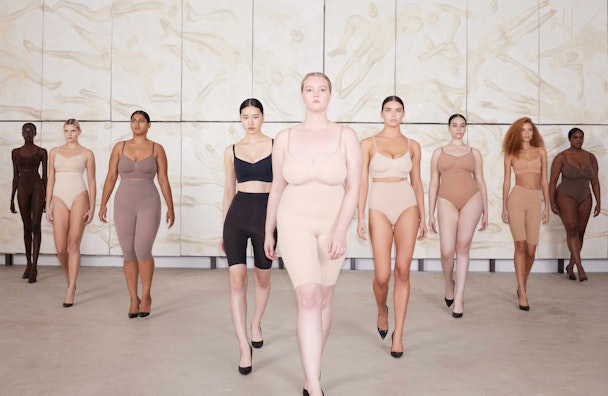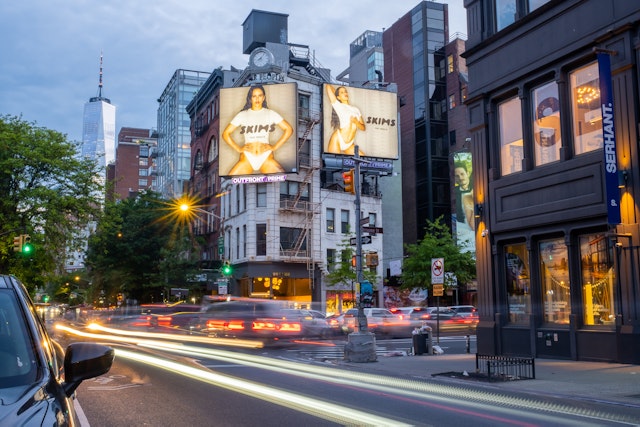Co-founder of Kim Kardashian’s $3.2bn viral brand Skims on moving away from paid social
The reality star’s shapewear empire is expected to report over $400m in sales for 2022. We catch up with its CEO, Jens Grede, to hear how he is ready to evolve its marketing strategy.

Shapewear brand Skims aims to cater to all sizes and skin tones / Vanessa Beecroft
Skims built its four-year-old, $3.2bn brand through platforms including Instagram and TikTok, but as the business matures it is looking to move away from its reliance on paid social and invest more in brand-building activities.
Under the leadership of adland veteran Jens Grede, Skims will soon pull back from traditional performance marketing, having found it is no longer an effective part of its media mix.
“If you look it from an ROI point of view, the cost of paid social has gone up so substantially over the past few years while the effectiveness is down trending,” Grede tells The Drum. “We don’t think the equation makes sense any more.”
Advertisement
Skims added over 2 million new customers in 2022, so its challenge is not in acquisition but retention. “We don’t have a customer problem. We like to invest dollars to build our brand, but paid social isn’t brand building.”
Skims’ media mix is increasingly weighted towards out-of-home, which it supplements with connected TV and paid influencer campaigns. For Grede, this out-of-home activity is both more affordable and more effective than TV and he says the brand’s aesthetic makes outdoor ads “really gratifying”.
To celebrate Skims’ one-year anniversary, it ran a series of giant billboard ads across New York and Los Angeles featuring some of its most high-profile customers. The combined social media following of the models in the campaign topped 27 million.

Grede was a co-founder of London-based fashion and luxury marketing agency Saturday Group (now Wednesday Agency), which he sold to BBDO in 2016. While working in adland, he was behind campaigns featuring Beyonce (for H&M) and Justin Bieber (Calvin Klein).
After more than a decade in agencies, however, he came to the conclusion that he no longer wanted to service the client – he wanted to be the client. His first brand venture in 2008 was the denim label Frame, which he ran for 10 years before setting up shop with Kim Kardashian in 2019. “The majority of my career I’ve spent in the intersection between popular culture and retail,” he explains.
Advertisement
Skims launched as a D2C retailer in 2019, starting first as a line of shapewear garments suitable for all sizes and skin tones and having since added loungewear, underwear and clothing.
“Kim [Kardashian] had a clear idea of the category and the product she wanted to develop. She felt she was underserved in that [shapewear] market and didn’t have enough solutions.”
Prior to Skims’ launch, the US shapewear market was dominated by brands such as Spanx, Love Shape Wear and Shapewear USA, but according to Grade the category had become ”stale”. So, he says, he and Kardashian spent two-to-three years on product development, despite there never being a fully-fledged commercial vision: “Marketing is great, but it is no substitute for poor product,” he says.
“It wasn’t really a light bulb moment. It started off as an idea around shapewear and merged into this category around clothing and underwear that just hadn’t existed before.”
Suggested newsletters for you
Creating viral campaigns
While there are no major changes to Skims’ marketing strategy in 2023, Grede says the business will invest more time and money in executing pop culture moments, with its marketing at its best when it creates campaigns that are “newsworthy by the content of the campaign”.
Recent activity, such as reuniting Victoria’s Secret models, bringing Brooke Shields out of retirement and its Christmas ad with Snoop Dog, are all examples of this strategy in play. “The virality of reuniting the former Victoria’s Secret Angles is larger than any media buy we can do for the same campaign.”
The brand has so far spent zero dollars on UK media and yet has managed to cut through: “It’s because we’ve been able to create big moments in social culture.”
With Kardashian as co-founder, it’s no surprise that Skims has been built on hype. With 4.7 million Instagram followers and a further million on TikTok, Grede says its online community “controls the brand narrative”.
“There’s no marketing a company can do to overshadow a bad review. It doesn’t work any more. When I worked for agencies, we had more control. But today, with how social is built for virality not for following, control is a total illusion for brands.”
Prior to Skims’ launch, it was leaked that the brand would be called Kimono. The company faced a subsequent backlash on social and in the press, leading to it issuing an apology and rebranding to Skims. “We were so tone-deaf,” admits Grede, but he says while “uncomfortable”, the experience was a “great teaching moment” to listen to your audience.
“We’ve always been a community-focused brand. We want the customer to own and grow the brand with us. Success today is almost becoming self-reinforcing.”

